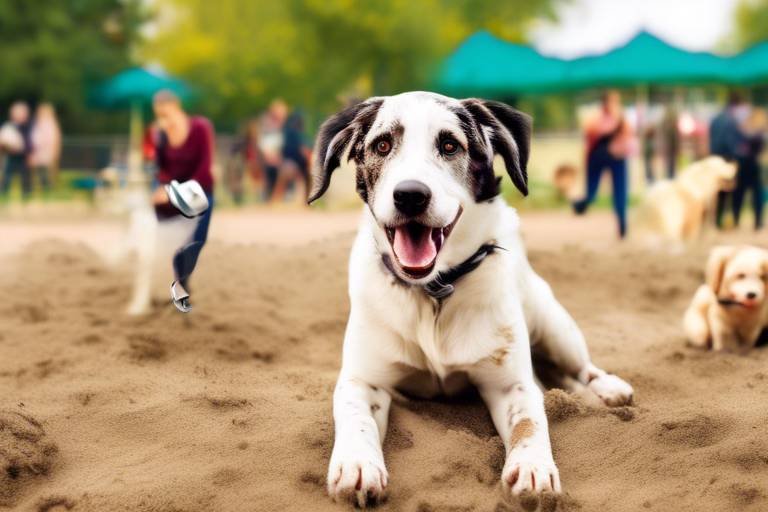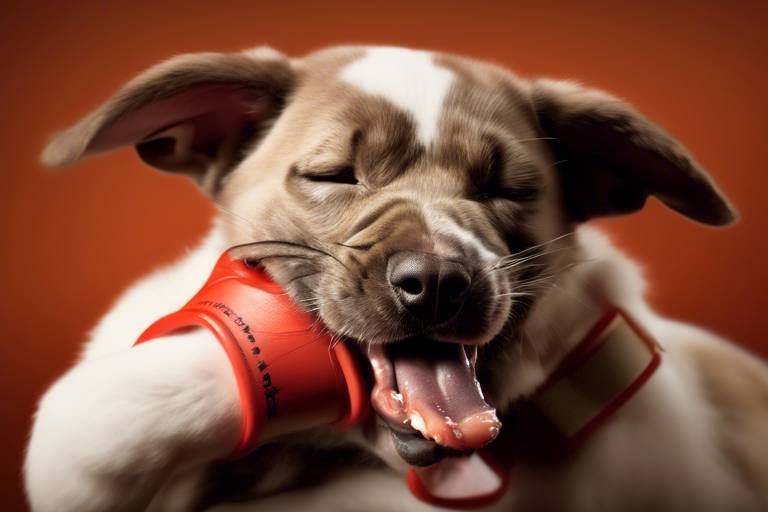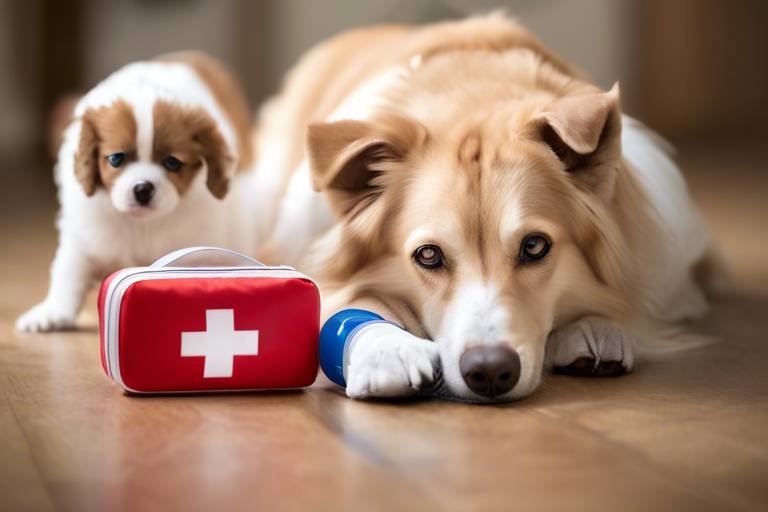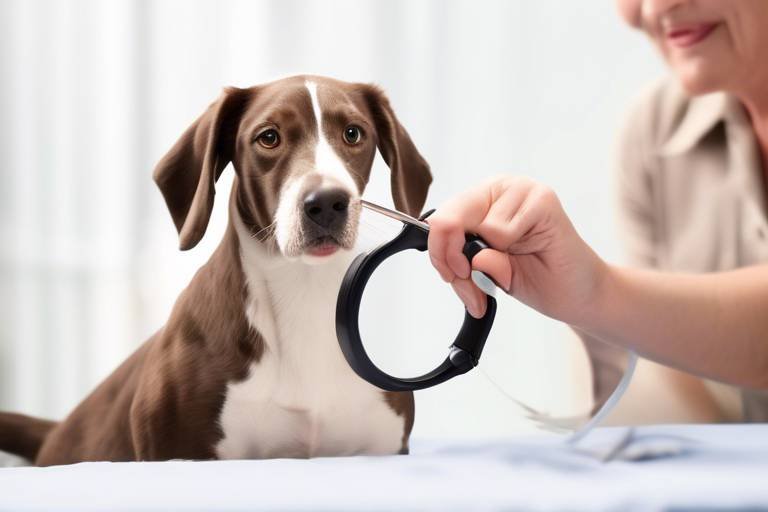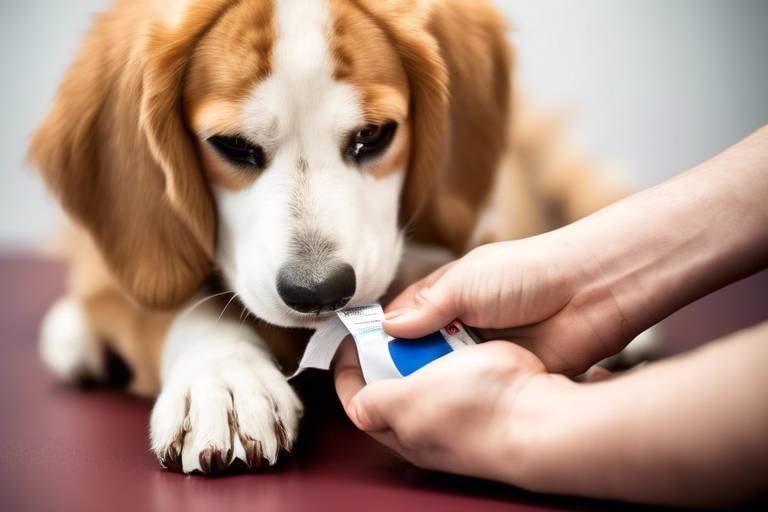How to Recognize and Address Pet Anxiety
Have you ever noticed your furry friend acting a bit off? Maybe they're hiding under the bed, barking at shadows, or just seem a little more clingy than usual. Pet anxiety is a common issue that can affect any pet, regardless of age or breed. Just like us humans, our pets can experience stress and anxiety, and it’s our job as loving pet owners to recognize the signs and take action. In this article, we’ll dive deep into understanding pet anxiety, spotting the signs, identifying the causes, and exploring effective strategies to help our beloved companions feel safe and secure.
Pet anxiety can manifest in various forms, impacting the emotional and physical health of your furry friends. Understanding its roots is crucial for effective management and support. Just imagine how you would feel if you were placed in a new environment, surrounded by loud noises and unfamiliar faces. Your pet feels that too! Anxiety in pets can lead to a range of behaviors, from destructive chewing to excessive barking, and even withdrawal from social interactions. By understanding what anxiety looks like in pets, we can better support their emotional well-being.
So, how do you know if your pet is anxious? Recognizing the signs of anxiety is essential for early intervention. Here are some common behaviors exhibited by anxious pets:
- Excessive Barking or Whining: If your dog is barking more than usual, it could be a sign of distress.
- Destructive Behavior: Chewing furniture or scratching at doors can indicate anxiety.
- Hiding: If your pet is retreating to their safe space often, they might be feeling overwhelmed.
- Changes in Eating Habits: A sudden loss of appetite or overeating can be a red flag.
- Pacing or Restlessness: If your pet can’t seem to settle down, it might be a sign of anxiety.
Recognizing these signs early can make a significant difference in your pet’s well-being.
Several factors can contribute to anxiety in pets, including changes in environment, past trauma, or lack of socialization. Understanding these causes can help owners provide better care. For instance, a pet that has experienced a traumatic event, like being abandoned or abused, may develop anxiety that lingers long after the incident. Similarly, pets that haven’t been properly socialized may feel overwhelmed in new situations.
Pets can be sensitive to changes in their surroundings. New environments, loud noises, or the presence of unfamiliar people can trigger anxiety in pets. Think about how you feel during a thunderstorm or when moving to a new house—those feelings of uncertainty can be just as intense for our pets. It’s essential to create a stable environment that helps your pet feel secure.
Did you know that certain breeds are more prone to anxiety due to their genetic makeup? Breeds like Border Collies or Chihuahuas may have a higher likelihood of developing anxiety. This subsection explores how genetics can influence a pet's temperament and susceptibility to anxiety, highlighting the importance of breed characteristics in understanding your pet's behavior.
Now that we’ve identified the signs and causes of pet anxiety, let’s explore some effective strategies for managing it. There are numerous techniques pet owners can implement to help alleviate their pets' anxiety, creating a calming environment that promotes relaxation.
Training can play a significant role in reducing anxiety. Positive reinforcement techniques can help pets feel more secure and confident. For example, teaching your pet commands such as “sit” or “stay” can provide them with a sense of structure and predictability. Incorporating regular exercise and mental stimulation into their routine can also work wonders in alleviating anxiety.
From pheromone diffusers to anxiety wraps, various products can assist in managing pet anxiety. These calming products can create a sense of security for your pet. For instance, Calming collars release soothing pheromones, while anxiety wraps provide gentle pressure that mimics a hug. It’s essential to research these products and consult with your veterinarian to find the best options for your pet.
Sometimes, anxiety can be severe enough to require professional intervention. If your pet’s anxiety is affecting their quality of life, it may be time to consult a veterinarian or animal behaviorist. They can provide tailored advice and may recommend treatments such as medication or specialized training programs. Remember, seeking help is not a sign of failure; it’s a step towards ensuring your pet’s happiness and well-being.
Q: How can I tell if my pet is anxious?
A: Look for signs such as excessive barking, destructive behavior, hiding, changes in eating habits, or restlessness.
Q: What can I do to help my anxious pet?
A: Implement behavioral training, create a calming environment, and consider using calming products.
Q: When should I seek professional help for my pet's anxiety?
A: If your pet's anxiety is severe and impacting their quality of life, it's time to consult a veterinarian or animal behaviorist.

Understanding Pet Anxiety
Pet anxiety is a complex emotional state that can affect our furry companions in various ways. Just like humans, pets can experience stress and anxiety, which can significantly impact their overall well-being. Understanding the nuances of pet anxiety is crucial for pet owners who want to provide a loving and supportive environment. Imagine your pet as a sensitive sponge, absorbing every little change in their surroundings. When that sponge gets too full, it can lead to anxiety, manifesting in behaviors that can be distressing for both the pet and the owner.
Pet anxiety can stem from a multitude of factors, and recognizing these factors is the first step towards effective management. For instance, a dog that used to be carefree may suddenly become anxious after a move to a new home or the introduction of a new family member. Similarly, cats may hide or exhibit aggressive behavior when faced with changes that disrupt their routine. Understanding the root causes of anxiety is essential, as it allows pet owners to tailor their approach to each individual pet's needs.
It's important to note that anxiety isn't just about being scared; it can also manifest as excessive barking, destructive behaviors, or even withdrawal from social interactions. Pets might also exhibit physical symptoms such as trembling, excessive grooming, or changes in appetite. These signs are their way of communicating that something isn't quite right. Recognizing these signs early on can help in addressing the issue before it escalates into more severe behavioral problems.
In the world of pet anxiety, knowledge is power. By educating ourselves about the signs, causes, and effective management strategies, we can become better advocates for our pets' mental health. Just as we would seek help for a friend or family member experiencing anxiety, we should be equally proactive in supporting our pets. After all, a happy pet is a happy home!

Common Signs of Anxiety in Pets
Recognizing the signs of anxiety in your beloved pets is crucial for their well-being. Just like humans, animals can experience stress and discomfort, which can manifest in various ways. The earlier you can identify these signs, the quicker you can intervene and provide the necessary support. So, what should you look out for?
Common behaviors that indicate anxiety in pets include excessive barking, whining, or meowing. These vocalizations are often their way of expressing distress. Additionally, you may notice your pet pacing back and forth, which can resemble a restless human trying to find a solution to an overwhelming problem. This behavior can be particularly pronounced in dogs, who might circle around or seem unable to settle down.
Another significant sign of anxiety is changes in appetite or grooming habits. An anxious pet may refuse to eat or may overeat as a coping mechanism. Similarly, they might groom themselves excessively, leading to skin irritations or bald patches. It's essential to monitor these changes closely, as they can also indicate other health issues.
Physical signs of anxiety can be just as telling. Watch for signs like panting, trembling, or hiding. If your pet suddenly seeks out small, enclosed spaces, it could be their way of trying to feel safe and secure. Cats, for example, may retreat under furniture, while dogs might try to squeeze into tight spots. It's their instinct to find a safe haven when they're feeling overwhelmed.
In addition to these signs, you might observe destructive behaviors. This can include chewing on furniture, scratching at doors, or digging in the yard. These actions often stem from a need to relieve stress or frustration. If you notice your pet engaging in these behaviors, it’s essential to address the underlying anxiety rather than just the behavior itself.
To summarize, here are some common signs of anxiety in pets:
- Excessive vocalization (barking, whining, meowing)
- Pacing or restlessness
- Changes in eating or grooming habits
- Physical signs like panting or trembling
- Seeking out hiding spots
- Destructive behaviors
By being vigilant and aware of these signs, you can take proactive steps to help your furry friends feel more at ease. Remember, just like us, pets thrive in environments where they feel safe and secure. If you notice these signs persistently, it might be time to consider strategies to alleviate their anxiety or consult a professional for guidance.

Causes of Pet Anxiety
Understanding the is crucial for pet owners who want to ensure their furry companions lead happy and healthy lives. Anxiety in pets isn't just a behavioral issue; it can stem from a variety of factors that affect their emotional well-being. One major contributor to anxiety is the environment in which a pet lives. For instance, if you've recently moved to a new home, your pet might feel disoriented and stressed due to unfamiliar surroundings. Loud noises, such as thunderstorms or fireworks, can also create a sense of dread and panic, leading to anxious behaviors.
Another significant factor is past trauma. Just like humans, pets can experience traumatic events that leave lasting impressions on their psyche. Rescue animals, for example, may have endured neglect or abuse before finding a loving home. These experiences can create a heightened sense of fear and anxiety, making it essential for owners to approach their care with patience and understanding.
Socialization plays a vital role in a pet's emotional health. Pets that have not been adequately socialized during their formative months may struggle to cope with new situations or unfamiliar people. This lack of exposure can lead to anxiety when faced with new experiences, such as meeting other animals or encountering new environments. To combat this, owners should gradually introduce their pets to various social settings, ensuring that these experiences are positive and rewarding.
Additionally, genetics can significantly influence a pet's temperament. Certain breeds are more predisposed to anxiety due to their genetic makeup. For example, breeds like the Border Collie and the Dachshund are known to exhibit higher anxiety levels compared to others. Understanding your pet's breed characteristics can help you anticipate and manage anxiety-related issues more effectively.
In summary, the causes of pet anxiety can be multifaceted, involving environmental factors, past experiences, socialization levels, and genetic predispositions. By recognizing these triggers, pet owners can create a supportive environment that fosters emotional stability and reduces anxiety.
Environmental Triggers
When it comes to our beloved pets, their environment plays a significant role in their emotional well-being. Just like humans, pets can be sensitive to changes in their surroundings, and these shifts can often trigger anxiety. Imagine moving to a new house or experiencing a loud thunderstorm; these scenarios can be stressful not just for us but for our furry companions as well. Pets thrive on routine and familiarity, and any disruption can lead to feelings of unease.
New environments can be particularly daunting for pets. When they are introduced to unfamiliar spaces, they may feel disoriented and anxious. This is especially true for dogs and cats that have been in the same home for a long time. They might display signs of stress, such as excessive barking, hiding, or even destructive behaviors. In fact, a study conducted by the American Veterinary Medical Association found that pets often exhibit anxiety-related behaviors when faced with new settings or changes in their daily routine.
Moreover, loud noises can be significant environmental triggers for pets. Whether it’s the sound of fireworks, thunderstorms, or even the vacuum cleaner, these sudden and loud noises can send pets into a panic. Many dogs, for instance, have a heightened sense of hearing, making them more susceptible to noise-related anxiety. You might notice your pet trembling, pacing, or seeking out a safe space to hide when such sounds occur. It's essential to create a secure environment for them during these times, perhaps by providing a cozy nook or using calming music to drown out the noise.
Additionally, the presence of unfamiliar people or animals can also induce anxiety in pets. Socialization is crucial for pets, especially during their formative years. However, if a pet hasn’t been adequately socialized, they may react fearfully when encountering new faces or other animals. This fear can manifest in various ways, including growling, barking, or attempting to flee. Understanding your pet's comfort level with new encounters is vital in managing their anxiety. Gradual introductions and positive reinforcement can help ease these tensions.
In summary, environmental triggers can significantly impact your pet's mental state. By being aware of these factors, you can take proactive steps to minimize stress and create a more comfortable living environment for your furry friends. Remember, a calm pet is a happy pet, and recognizing the signs of environmental anxiety can lead to a happier, healthier life for them.
Genetic Predisposition
When it comes to our beloved pets, their genetic makeup plays a crucial role in shaping their behavior and emotional responses. Just like humans, animals inherit traits from their parents, and some breeds are more susceptible to anxiety than others. For instance, breeds like Border Collies, German Shepherds, and Chihuahuas often display higher levels of anxiety due to their inherent traits. This predisposition can stem from various factors, including their history, breeding practices, and even the environments they were raised in.
Understanding the genetic predisposition to anxiety in pets is essential for pet owners. It's not merely a matter of personality; it’s about recognizing that some animals may have a biological inclination toward anxiety. This awareness can help owners tailor their approach to training and care. For example, if you have a breed known for anxiety, you might consider proactive measures like early socialization or consistent training routines to help mitigate their stress levels.
Moreover, it’s fascinating to note that the effects of genetics can be compounded by environmental factors. A pet with a genetic predisposition to anxiety may develop more severe symptoms if placed in a stressful environment. This interplay between genetics and environment can create a perfect storm for anxiety in pets. Therefore, being aware of your pet’s breed characteristics can empower you to create a more supportive and understanding home.
In summary, while genetics can predispose pets to anxiety, it’s essential to remember that it’s just one piece of the puzzle. By combining knowledge of breed tendencies with effective training techniques and a nurturing environment, you can significantly improve your pet's emotional well-being. After all, a happy pet is a healthy pet!
- Q: Can all pets experience anxiety?
A: Yes, all pets can experience anxiety, but the severity and triggers can vary widely among different animals and breeds. - Q: How can I tell if my pet is anxious?
A: Look for signs such as excessive barking, destructive behavior, hiding, or changes in appetite. If you notice these signs, it may be time to address their anxiety. - Q: Are there specific breeds that are more prone to anxiety?
A: Yes, certain breeds like Border Collies, German Shepherds, and Chihuahuas are known to have a genetic predisposition to anxiety. - Q: What should I do if my pet's anxiety doesn't improve?
A: If your pet's anxiety persists, consider consulting a veterinarian or an animal behaviorist for professional guidance.

Effective Strategies for Managing Anxiety
When it comes to managing pet anxiety, it's essential to remember that each furry friend is unique. What works for one pet may not work for another, so a little trial and error might be necessary. However, there are several effective strategies that can help soothe your anxious companion and create a more relaxed environment. First and foremost, establishing a routine can provide your pet with a sense of security. Animals thrive on predictability, so feeding, walking, and playtime should happen at the same time each day. This structure can significantly reduce anxiety levels.
Another vital strategy is to create a calm environment. This can be achieved by providing a safe space where your pet can retreat when feeling stressed. Consider setting up a cozy corner with their favorite blanket or bed, away from loud noises or chaotic activity. Using soft lighting and calming music can also contribute to a serene atmosphere. Additionally, incorporating interactive toys can help distract your pet and keep their mind engaged, which is especially useful during stressful situations.
Behavioral training techniques are another powerful tool in your anxiety management arsenal. Positive reinforcement training can help your pet build confidence and learn to cope with anxiety triggers. Start by rewarding your pet for calm behavior and gradually introduce them to situations that typically cause stress. This gradual exposure can help desensitize them to their fears. For instance, if your dog is anxious around strangers, invite a friend over to help your dog associate new people with positive experiences—like treats or playtime.
In addition to training, various calming products are available that can assist in managing anxiety. These include pheromone diffusers, which release calming scents that can help soothe your pet, and anxiety wraps that provide gentle pressure, mimicking the feeling of being held. Some pet owners have found success with natural supplements, such as CBD oil or calming chews, designed specifically for pets. It's always wise to consult your veterinarian before introducing any new products to ensure they are safe and appropriate for your pet.
Lastly, never underestimate the power of socialization in reducing anxiety. Gradually exposing your pet to new experiences, people, and environments can help them become more adaptable and less fearful. Start small—take your pet for short walks in new areas or invite friends over for brief visits. Over time, these positive experiences can help build your pet's confidence and reduce anxiety levels. Remember, patience is key; change won’t happen overnight, but with consistent effort, you can make a significant difference in your pet's emotional well-being.
- What are the first signs of anxiety in pets? Look for behaviors such as excessive barking, hiding, destructive chewing, or changes in appetite.
- Can anxiety in pets be treated without medication? Yes, many pets can benefit from behavioral training, calming products, and environmental changes.
- How long does it take to see improvements in my pet's anxiety? It varies by pet, but consistency in training and environmental adjustments can lead to noticeable changes within weeks.
- When should I consult a veterinarian about my pet's anxiety? If your pet's anxiety is severe or persistent, or if it leads to harmful behaviors, it's time to seek professional help.
Behavioral Training Techniques
When it comes to helping our furry friends overcome anxiety, can be a game changer. Just like humans, pets thrive on structure and predictability, and training can provide them with the tools they need to feel more secure in their environment. One effective method is positive reinforcement, which involves rewarding your pet for desired behaviors rather than punishing them for unwanted ones. This technique not only encourages good behavior but also builds a stronger bond between you and your pet.
Consider the following techniques to help alleviate your pet's anxiety:
- Desensitization: Gradually exposing your pet to the source of their anxiety in a controlled manner can help them adjust. For example, if your dog is afraid of loud noises, you might play recordings of those sounds at a low volume while rewarding them for staying calm.
- Counter-conditioning: This technique involves changing your pet's emotional response to a stimulus. For instance, if your cat gets anxious during vet visits, you could start associating those visits with treats and playtime.
- Routine Establishment: Pets, especially dogs, benefit from a consistent daily routine. Regular feeding, walking, and playtimes can create a sense of security and predictability, which can significantly reduce anxiety levels.
Moreover, incorporating mental stimulation into your pet's daily routine can also be beneficial. Engaging your pet's mind can distract them from their anxiety triggers. Puzzle toys, interactive games, and training sessions can provide not only entertainment but also a mental workout for your furry friend. Think of it as a form of pet yoga—it helps them focus and relax.
Lastly, it's essential to remain patient and consistent with these training techniques. Just like us, pets need time to adjust and learn new behaviors. Celebrate the small victories along the way, and don't hesitate to seek the help of a professional trainer if you feel overwhelmed. After all, the goal is to create a calm and happy environment for your beloved pet, and sometimes a little extra guidance can make all the difference.
Q: How long does it take for behavioral training techniques to work?
A: The time it takes for behavioral training to show results varies by pet and their specific anxiety triggers. Some pets may respond within a few weeks, while others may take several months. Consistency and patience are key.
Q: Can I train my pet myself, or should I hire a professional?
A: Many pet owners successfully implement training techniques on their own. However, if your pet's anxiety is severe or if you feel unsure about the process, seeking help from a professional trainer or animal behaviorist can be beneficial.
Q: Are there any specific breeds more prone to anxiety that might require special training techniques?
A: Yes, certain breeds, such as Border Collies, Dachshunds, and Chihuahuas, may be more susceptible to anxiety. These breeds might benefit from tailored training approaches that address their unique needs.
Calming Products and Treatments
When it comes to alleviating pet anxiety, the market is flooded with a plethora of calming products and treatments designed to help our furry companions find their zen. Just like humans, pets can benefit from a little extra support during stressful times. Imagine being in a crowded room with loud music; wouldn’t a cozy corner with soft lighting and soothing sounds be a relief? That’s exactly what these products aim to provide for your pets.
One popular option is pheromone diffusers. These nifty devices release synthetic versions of the calming pheromones that mother dogs or cats produce to comfort their young. By mimicking these natural scents, pheromone diffusers can help create a serene environment that soothes anxious pets. They are particularly effective for pets that experience anxiety during thunderstorms or fireworks, as they can help mask the overwhelming sounds with a sense of safety.
Another effective treatment is the use of anxiety wraps. Think of these wraps as a gentle hug for your pet. They apply light, consistent pressure to the body, which can have a calming effect on anxious animals. Many pet owners have reported significant improvements in their pets' behavior when using these wraps during stressful situations, such as vet visits or travel. It's like giving your pet a comforting embrace when they need it the most.
In addition to these physical products, there are also natural supplements available that can help ease anxiety. Ingredients like L-theanine, chamomile, and valerian root are commonly found in these formulations. They work by promoting relaxation and reducing stress levels in pets. However, it’s crucial to consult with a veterinarian before introducing any new supplements to your pet’s routine to ensure they are safe and appropriate.
For those looking for a more holistic approach, aromatherapy can also be beneficial. Certain essential oils, when used safely, can create a calming atmosphere for pets. Oils like lavender and chamomile are known for their soothing properties. Just make sure to use pet-safe oils and consult with a professional before diffusing them in your home, as some essential oils can be toxic to animals.
It's important to remember that while these products can be incredibly helpful, they are most effective when combined with behavioral training and a loving environment. Think of them as tools in your pet care toolbox; each one plays a role in building a supportive and calming atmosphere for your furry friends. Just like a well-rounded diet is essential for good health, a combination of calming products and positive reinforcement training can lead to a happier, more relaxed pet.
In summary, whether you choose pheromone diffusers, anxiety wraps, natural supplements, or aromatherapy, the key is to find what works best for your pet. Every animal is unique, and what calms one may not work for another. By exploring these options, you can help your pet navigate their anxiety and promote a sense of peace in their lives.

When to Seek Professional Help
Recognizing when your pet's anxiety has escalated beyond what you can manage at home is crucial for their well-being. Just like us, pets can experience anxiety that may require professional intervention. If you notice that your furry friend is exhibiting extreme behaviors that seem out of character, it’s time to take a step back and evaluate the situation. But how do you know when it's time to consult a veterinarian or an animal behaviorist?
First and foremost, if your pet is displaying signs of severe anxiety—such as persistent barking, destructive behavior, or excessive hiding—these can be red flags. It's important to note that while occasional anxiety is normal, chronic anxiety can lead to serious health issues, both physical and emotional. If your pet’s anxiety is affecting their quality of life, seeking professional help is not just advisable; it’s essential.
Another significant indicator is if your pet is exhibiting signs of aggression. This can manifest as growling, snapping, or even biting. An anxious pet may feel cornered and lash out as a defense mechanism. If you find yourself in a situation where your pet is becoming aggressive, it’s imperative to consult with a professional who can provide guidance on how to safely manage these behaviors.
Additionally, if home remedies and behavioral techniques you've tried seem ineffective after a reasonable amount of time, this is another cue that it might be time to reach out for help. Sometimes, anxiety can be deeply rooted in your pet's psyche, and professional trainers or veterinarians can offer specialized techniques or medications that you may not be aware of.
To help you gauge whether your pet needs professional help, consider the following factors:
- Duration: Has your pet been anxious for weeks or months without improvement?
- Severity: Are the symptoms escalating or becoming more severe over time?
- Impact on Daily Life: Is your pet's anxiety affecting their ability to eat, sleep, or engage in normal activities?
- Behavior Changes: Have you noticed any drastic changes in your pet's behavior, such as withdrawal or aggression?
In conclusion, while it’s natural to want to help your pet through their anxiety, sometimes professional intervention is the best course of action. Don't hesitate to reach out to a veterinarian or a qualified animal behaviorist if you feel overwhelmed or if your pet's anxiety appears to be worsening. Remember, seeking help is a sign of a responsible pet owner who cares deeply about their furry companion's health and happiness.
Here are some common questions pet owners have regarding anxiety in pets:
- Q: What are the first signs of anxiety in pets?
A: Common signs include excessive barking, hiding, pacing, and changes in appetite. - Q: Can anxiety in pets be treated without medication?
A: Yes, many pets can benefit from behavioral training and calming products. - Q: How long does it take for a pet to feel better after starting treatment?
A: The timeline can vary, but many pets show improvement within a few weeks of consistent treatment. - Q: Is pet anxiety common?
A: Yes, anxiety is quite common in pets, especially during significant life changes.
Frequently Asked Questions
- What are the common signs of anxiety in pets?
Pets can show a variety of signs when they are feeling anxious. Look for behaviors like excessive barking, hiding, destructive chewing, or changes in eating habits. If your pet seems unusually clingy or avoids social interaction, these could also be red flags indicating anxiety.
- What causes anxiety in pets?
There are several factors that can contribute to anxiety in pets. Changes in their environment, such as moving to a new home or the introduction of new family members, can be stressful. Past trauma, lack of socialization, or even genetic predispositions in certain breeds can also play a significant role in their anxiety levels.
- How can I help my pet manage anxiety?
There are numerous strategies you can implement to help your pet feel more secure. Behavioral training techniques, such as positive reinforcement, can build their confidence. Additionally, creating a calming environment with soft music or designated safe spaces can make a world of difference. Don't forget to explore calming products like pheromone diffusers or anxiety wraps!
- When should I seek professional help for my pet’s anxiety?
If your pet's anxiety seems severe or is affecting their daily life, it might be time to consult a veterinarian or an animal behaviorist. Signs that professional help is needed include persistent destructive behavior, extreme fear responses, or if your pet is unable to relax even in familiar settings.
- Can certain dog breeds be more prone to anxiety?
Yes, some dog breeds are genetically predisposed to anxiety. Breeds like Border Collies, Chihuahuas, and German Shepherds are known to exhibit higher anxiety levels. Understanding your pet's breed characteristics can help you anticipate and manage potential anxiety issues more effectively.


